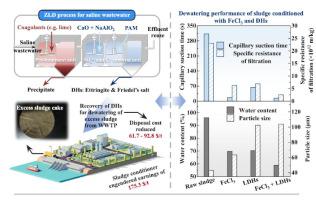Chemical Engineering Journal ( IF 13.3 ) Pub Date : 2022-01-20 , DOI: 10.1016/j.cej.2022.134787 Jiaming Guo 1 , Zhen Zhou 1, 2 , Dongqi Sun 1 , Li Zeng 1 , Qiang Ming 1 , Yunxin Xing 1 , Zhuojun Huang 1 , Xiaodan Zhao 1

|
The massively generated double-metal hydroxides (DHs) precipitate has restricted the application of the lime-aluminum precipitation method in the zero liquid discharge (ZLD) process of saline wastewater. Recovering DHs precipitate as conditioners for the dewatering of municipal sludge is a promising solution for above issue. In this study, individual use of DHs from the ZLD process, including ettringite (Ett), Friedel’s salt (FS) and their mixtures (EF), and combined use of the DHs and FeCl3 in sludge conditioning were investigated. The EF precipitate was commonly generated from the chloride precipitation process by the lime-aluminum method, and composed of 16.7% of Ett and 83.3% of FS. The dewaterability of excess sludge conditioned with FeCl3 prior to DHs was much better than opposite dosing sequence and individual use of DHs. Sludge conditioned by FeCl3 prior to EF possessed the best dewatering performance ascribing to its high fluidity, strong structure strength and uniformly dispersed mesoporous structure. The variations of extracellular polymeric substances (EPS) further confirmed that EPS were largely released after FeCl3 addition and then efficiently adsorbed by the subsequently added DHs, with the highest adsorption efficiency of 60% by EF. The kinetics for EPS adsorption also suggested that EF had the highest adsorption capacity compared to FS and Ett. Overall, FeCl3 addition could form interstitial channels in flocs by penetration and release external and intracellular substances, while the latter added EF, Ett could function as uniformly skeleton material and dispersing agent to improve EPS adsorption by FS. Hence, the synergic coupling of FeCl3 and DHs as chemical conditioner is inspirable and economically beneficial to ZLD and advanced sludge dewatering process.
中文翻译:

回收含盐废水脱盐过程中的双金属氢氧化物沉淀物作为剩余污泥脱水的调节剂
大量生成的双金属氢氧化物(DHs)沉淀限制了石灰铝沉淀法在含盐废水零液体排放(ZLD)工艺中的应用。回收 DHs 沉淀物作为市政污泥脱水的调节剂是解决上述问题的有希望的解决方案。在这项研究中,对来自 ZLD 工艺的 DHs 的单独使用,包括钙矾石 (Ett)、弗里德尔盐 (FS) 及其混合物 (EF),以及 DHs 和 FeCl 3在污泥调理中的组合使用进行了调查。EF沉淀物通常由石灰-铝法氯化物沉淀过程产生,由16.7%的Ett和83.3%的FS组成。FeCl 3处理剩余污泥的脱水性能在 DHs 之前比相反的给药顺序和单独使用 DHs 好得多。EF前FeCl 3处理的污泥具有最佳的脱水性能,这归因于其高流动性、强结构强度和均匀分散的介孔结构。胞外聚合物(EPS)的变化进一步证实了EPS在添加FeCl 3后大量释放,然后被随后添加的DHs有效吸附,EF的最高吸附效率为60%。EPS 吸附动力学也表明,与 FS 和 Ett 相比,EF 具有最高的吸附容量。总体而言,FeCl 3添加EF、Ett可作为均匀骨架材料和分散剂,促进FS对EPS的吸附。因此,FeCl 3和DHs作为化学调节剂的协同耦合对于ZLD和先进的污泥脱水工艺具有启发性和经济性。











































 京公网安备 11010802027423号
京公网安备 11010802027423号